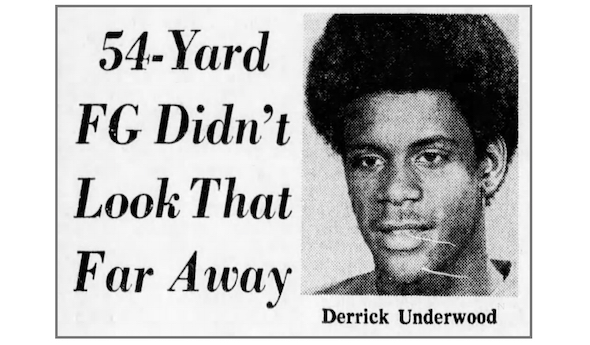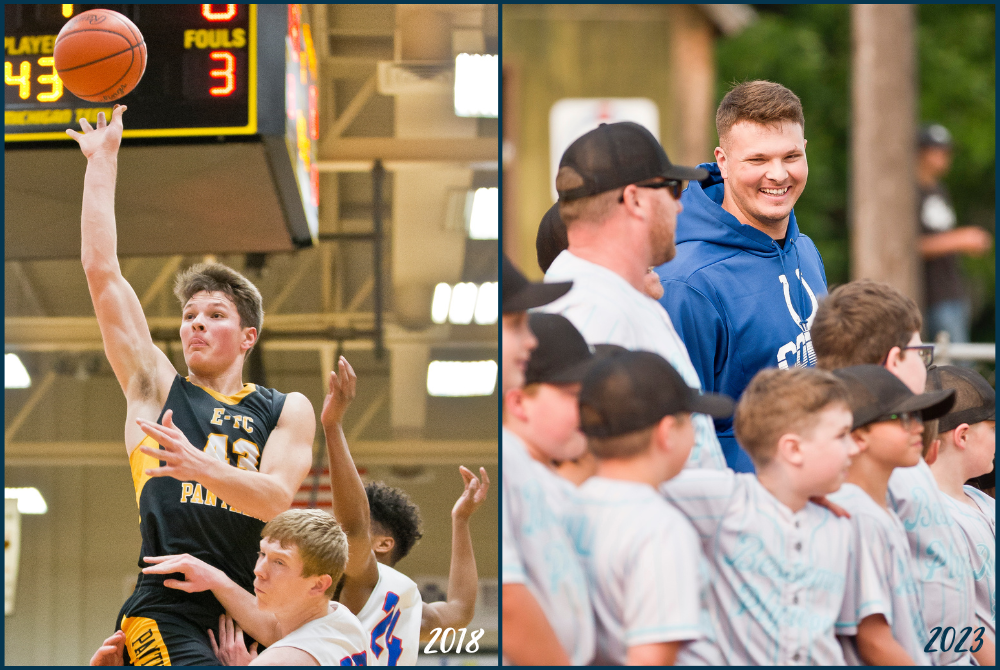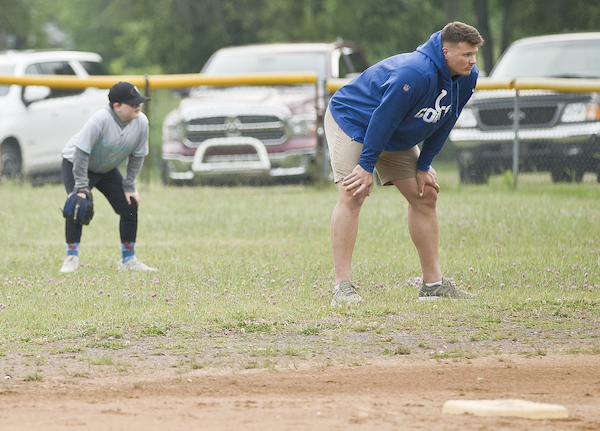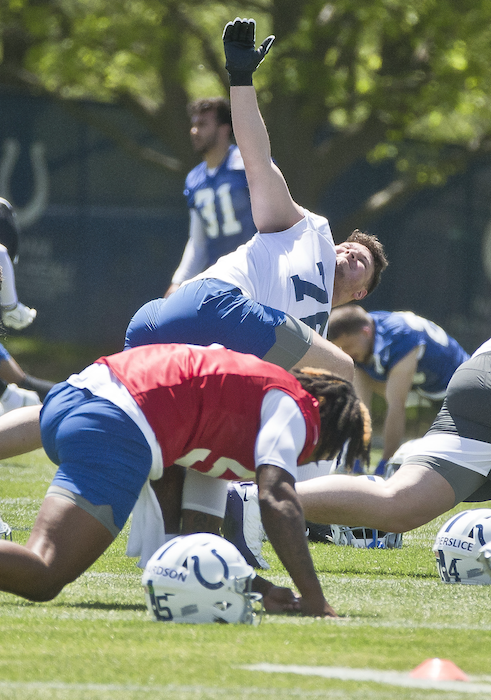
Search for Longest FG Starts in '50s
October 30, 2020
By Ron Pesch
Special for Second Half
Rob LaMielle’s first attempted field goal was a memorable one, and frankly, a bit amazing.
For starters, his track record on extra points, at least to that point in the season, was less than stellar. Flint Holy Redeemer entered their third game of the 1963 slate with a 1-1 record. The Flyers were defeated by Bad Axe in Week 1, then trounced Imlay City the next week. The senior had been successful on only 3 of 9 extra-point placements on the year.
“You had to bring that up,” said LaMielle over 55 years later, laughing at the statistic. “That’s probably so. Bad Axe was rated No. 1 in the state in Class ‘B.’ We were a ‘C’ school. They beat us 13-12 that night, because I missed two extra points. They scored in the very last couple minutes.”
The fact that his field goal was on the mark is all the more impressive considering it traveled 50 yards, clearing the crossbar by three feet, according to observers. Even more remarkable, it was a mere three yards shy of Lou ‘The Toe’ Groza’s best effort for the National Football League’s Cleveland Browns, and just six yards short of the NFL record, set by Bert Rechichar of the Baltimore Colts in 1953. Rechichar held the mark until it was famously topped by New Orleans Saints kicker Tom Dempsey in 1970 against the Detroit Lions.
“We practiced behind our football field,” said LaMielle, recalling how he got the job. “Behind our football field was two baseball fields with a backstop at each end. Well the coach lined everybody up on second base and said, ‘OK, we’re going to find out who can kick a field goal.’ So we started kicking the ball over the backstop. One of the times I kicked it, and it went a long ways.”
St. Redeemer’s coach Dick Clark stopped the drill and named LaMielle the team’s kicker.
“Before my senior year, I’d never kicked off, never attempted an extra point.”
At the time, the 220-pound LaMielle, who, like Groza, played tackle, was asked if he was surprised by the success of his kick.
“I was more surprised Coach Clark asked me to try it,” he said.
The field goal helped Flint Holy Redeemer top Bay City St. James, 29-6.
It also prompted another question from sports reporters. Was LaMielle’s kick a Michigan high school record?
The Search
The publicity surrounding the kick sent sportswriters around the state scurrying for the archives.
 Initial inquiries indicated that Jim Yore of Battle Creek Central held the state mark, with a 56-yard field goal about 10 years prior, but a recheck of records by Dick Kishpaugh, “sports publicity director at Kalamazoo College and a close observer of Michigan prep football records,” indicated that Yore’s longest had been a 38-yard field goal, kicked on the last play of the game to beat Ypsilanti 3-0 on Oct. 3, 1952. It was thought to be the longest in state history.
Initial inquiries indicated that Jim Yore of Battle Creek Central held the state mark, with a 56-yard field goal about 10 years prior, but a recheck of records by Dick Kishpaugh, “sports publicity director at Kalamazoo College and a close observer of Michigan prep football records,” indicated that Yore’s longest had been a 38-yard field goal, kicked on the last play of the game to beat Ypsilanti 3-0 on Oct. 3, 1952. It was thought to be the longest in state history.
Additional digging found that Port Huron High School’s Alfred Davis, a 212-pound fullback, had drilled a flawless 46-yard field goal in a 19-14 win over Hazel Park in 1953.
“The word ‘tremendous’ is probably one of the most overused words in sports lexicon,” wrote Port Huron Times reporter Fred J. Vincent, “but it should be used in describing this kick.”
Vincent called it “perfect, splitting the uprights and clearing the bar by about six feet.”
Impressively, Davis also had kicked a 36-yarder earlier in the contest. “Bob Boyd held on both kicks,” added the sportswriter. “Not since Oct. 8, 1930 had a Big Red player kicked a three pointer. Hank Ceasor did it then to best Ferndale, 3-0.”
Word came that Cheboygan Catholic’s Joe Poirier had kicked one “reported to have traveled at least 53 yards from the point of the kick to the goal posts” in a 10-0 victory over Alcona in 1957. Since the MHSAA didn’t keep records at the time, Kishpaugh added it to his listing of unofficial state records.
The Ironwood Daily Globe unearthed a nugget. While it wasn’t considered by Kishpaugh for his record book, it did bring back memories of changes seen in the game.
Ironwood’s John ‘Cutz’ Cavosie made a “tremendous boot on Oct. 10, 1925 in the final seconds of a game at Oliver Field here in which Ironwood swamped Menominee 41-0. Cavosie apparently was back to punt, but instead he dropkicked the ball squarely through the goal posts 55 yards away. He was in his senior year that fall and was captain of the team. He played a big role in the rout on Menominee by scoring on runs of 42, 51 and 67 yards.”
Record Toppled
So it was quite the event when, nearly 19 years later, junior Derrick Underwood broke Poirier’s mark on a cold October Friday at Inkster.
A week earlier, Underwood had made his first field goal of the season, a 23-yard boot in overtime to give Ecorse its first victory of the year in five starts, 9-6, over River Rouge. This time, his kick gave Ecorse a 3-0 victory over the Vikings, although in decidedly less dramatic fashion as the kick came in the second quarter.
 “The strange thing is I didn’t even know that I was kicking it from the 44-yard line. To be honest, I wasn’t paying that much attention and it didn’t look that long,” Underwood told the Detroit Free Press in 1976. “But I got a real good snap on it and an excellent hold.
“The strange thing is I didn’t even know that I was kicking it from the 44-yard line. To be honest, I wasn’t paying that much attention and it didn’t look that long,” Underwood told the Detroit Free Press in 1976. “But I got a real good snap on it and an excellent hold.
Red Raiders coach Patrick Kearney believed the kick would have been good from another five or 10 yards out.
“It felt good when I hit it,” added Underwood, “but because I was in front of the goal posts, I couldn’t tell whether it went over or under the crossbar. But I saw my teammates jumping up and down on the sidelines and I knew it made it.
“I was pretty loose because I figured that if I missed, we still had another half to come back and win it.”
Underwood’s accomplishment garnered national attention in the June/July ’77 issue of Joe Namath’s National Prep Sports magazine. At the time, Jerry Spicer of Hobart (Ind.) High School held the national record with a kick of 61 yards in 1975.
Exasperation to Jubilation
Underwood, who also served as the Red Raiders’ quarterback and defensive end, guided the team to Inkster’s one-foot line in that same game as the clock wound down. But with the lead, instead of pushing for the end zone, they let time expire.
A year earlier, in 1975, the Ecorse players watched their season disappear after a single game.
“The school millage was defeated just prior to the start of that season,” said Underwood, recalling his high school days some 45 years later. “I was the starting QB for the Red Raiders through my senior year ('78). We were heartbroken that our season was over after the first game against Muskegon Heights. No energy for that game.
“We were foaming at the mouth to be playing organized football. Some of us played flag football to stay active.”
“I was just practicing holding for a teammate,” Underwood had told the Free Press back in October 1976. “Eventually I thought I’d try and I got to be pretty good at it.”
“I didn’t take kicking seriously at all,” he states now. “I wasn’t a dedicated kicker. My stars were aligned in my head as being the next Thomas Lott.”
 Lott, a Parade All-American out of San Antonio, Texas, played quarterback at Oklahoma, where his coach, the legendary Barry Switzer, once called him the greatest wishbone quarterback in Oklahoma history.
Lott, a Parade All-American out of San Antonio, Texas, played quarterback at Oklahoma, where his coach, the legendary Barry Switzer, once called him the greatest wishbone quarterback in Oklahoma history.
“Went down to Tennessee State University and found out how much football I didn’t know,” Underwood said.
Reminiscing he added, “Looking back, wouldn’t change a thing growing up in Ecorse.”
Equaled, then Topped – in the Same Game
Underwood’s mark would hold in Michigan until 1979, when junior Harold Moore of Dearborn equaled, then topped the mark in a season-ending game against Plymouth Canton.
Moore, a left-footed, straight-on kicking specialist, matched Underwood’s record with a 54-yard boot in the game’s first half, and then topped the record with a 55-yard field goal during the second half.
“I’ve never seen anyone with the leg power he has,” said his coach, Dick Ryan. “His 55-yard field goal cleared the bar with 20 feet to spare.”
Over the next two seasons, three players – Mike Prindle of Grand Rapids Union (1980), Bob Hirschman from Sterling Heights Ford (1980), and Dave Blackmer of Farmington Hills Harrison (1981) – would match Moore’s longest kick.
Since then, only five players have matched or exceeded 55 yards. John Langeloh of Utica shattered the mark in 1985 with a 58 yarder. Doug Kochanski of Warren Woods-Tower is the state’s current record holder, with a kick in 1994 that traveled 59 yards before splitting the uprights. The successful kick came in his final high school contest.
In these days of more and more specialization, one wonders, will Michigan ever see one of 60 yards or more?
 Ron Pesch has taken an active role in researching the history of MHSAA events since 1985 and began writing for MHSAA Finals programs in 1986, adding additional features and "flashbacks" in 1992. He inherited the title of MHSAA historian from the late Dick Kishpaugh following the 1993-94 school year, and resides in Muskegon. Contact him at [email protected] with ideas for historical articles.
Ron Pesch has taken an active role in researching the history of MHSAA events since 1985 and began writing for MHSAA Finals programs in 1986, adding additional features and "flashbacks" in 1992. He inherited the title of MHSAA historian from the late Dick Kishpaugh following the 1993-94 school year, and resides in Muskegon. Contact him at [email protected] with ideas for historical articles.
PHOTOS: (Top) The Detroit Free Press told the story behind Derrick Underwood’s record field goal for Ecorse in its Oct. 30, 1976 edition. (2) Battle Creek Central’s Jim Yore was one of the earliest record holders for longest field goal in Michigan high school history. (3) Alfred Davis also was a standout fullback for Port Huron. (4) Underwood also played quarterback and defensive end for the Red Raiders. (Photos gathered by Ron Pesch.)

E-TC's Witt Bulldozing Path from Small Town to Football's Biggest Stage
By
Jason Juno
Special for MHSAA.com
June 28, 2024
Ewen-Trout Creek graduate Jake Witt is playing for a spot on the Indianapolis Colts’ 53-man roster. The memories of high school sports, and the impact they’ve had on his journey to the NFL, have stuck with him through his college days and even now as a professional.
 The 300-plus receiving yards he went for in a game against the eventual 8-player state champion back in 2017.
The 300-plus receiving yards he went for in a game against the eventual 8-player state champion back in 2017.
The regular-season basketball game where 3,276 fans turned out to watch his Panthers play just a few months later.
The teamwork prep sports taught him. The family atmosphere he got to be a part of on the high school football team.
“Football was definitely the sport I felt the most family-type feeling with it,” Witt said earlier this week after fishing on Erickson Lake while back in the Upper Peninsula before training camp begins next month. “That’s what drew me back to wanting to play football in college, was my opportunity in high school to play and getting that feeling with the guys and that family-oriented feel.”
Witt played two years of high school football. He lined up exclusively at wide receiver for Ewen-Trout Creek as a junior and then was more of a blocking tight end when E-TC and Ontonagon joined forces as a co-op program when he was a senior.
He ultimately decided to play basketball first in college, at Michigan Tech. But two of his three finalists were football opportunities.
“Obviously playing basketball from second grade on, people would probably assume that I would want to play basketball in college,” Witt said. “I think that just goes to show that football in those two years had a big impact and obviously it led me to where I am when I played at Northern and where I am today.”
Witt played only one year of basketball at Tech. He transferred to Northern Michigan University to attend as a student only before being talked into playing football.
He was initially a tight end there before moving to tackle because of injuries during a game against Ferris State. He dominated, not allowing a sack or even a quarterback pressure against what was considered the best Division II defensive line in the country.
He stayed at tackle for what was left of that season and then all of his final year at Northern. Despite his limited time at the position, he had the attention of NFL scouts and entered the draft. The attention reached a fever pitch during his pro day at Central Michigan when he wowed with his athleticism. His 9.92 Relative Athletic Score, a way to measure players’ athletic testing while accounting for their size, was one of the best for an offensive tackle prospect since it began being used in 1987.
 He was drafted with the 236th pick, in the seventh round, by the Colts in 2023.
He was drafted with the 236th pick, in the seventh round, by the Colts in 2023.
His first training camp was cut short due to a hip injury, and he was then placed on season-ending injured reserve. But he’s back healthy and ready to go. He practiced at second-string left tackle during the offseason camp this spring and now hopes to earn a spot on the 53-man roster with training camp set to begin in a month.
“I want to go into training camp, play well and then play well enough to where they can’t release me off the 53,” Witt said. “The next goal is to play in a game. And I think that will start with special teams, that will start with field goal. And then from there, obviously, everybody is one week of great practice away from playing with the offense, one injury away from playing in a game with the offense.”
Those who watched him during his high school days in the U.P. likely wouldn’t be at all surprised to see that happen.
Witt is still the only receiver to go for 300 or more receiving yards in 8-player football in state history, according to the MHSAA record book. And he did it twice, a 325-yard game against Eben Junction Superior Central as a junior and the 305-yard performance against Crystal Falls Forest Park as a senior.
The Ontonagon co-op team had mostly stuck to running the ball that season, but looked for Witt through the air against the eventual state champion Trojans.
“I think it was 345 (yards), I think they sent in the wrong number,” Witt said. “That was one game where we switched things up with our offensive attack and threw the ball a lot more, and it ended up paying off for us very well. We were down big at halftime, and we pushed back and we were in a battle with them in the second half. It was a great game. We didn’t end up winning, but it was a lot of fun.”
He enjoyed both years of high school football – even while mostly blocking on the line as a senior despite having shown previously to be a more-than-capable receiver.
 “A lot of the offense wasn’t focused on me anymore, which was great,” Witt said. “It made me a much more well-rounded football player. It made me a much better athlete, it gave me a better perception on things as a football player versus just being a receiver. I think both years were great for different reasons.”
“A lot of the offense wasn’t focused on me anymore, which was great,” Witt said. “It made me a much more well-rounded football player. It made me a much better athlete, it gave me a better perception on things as a football player versus just being a receiver. I think both years were great for different reasons.”
Witt said every sport he played in high school was beneficial to him going forward. Basketball, for example, taught him teamwork and coordination.
“And just relationship building is huge; for me, it helped me move on to the professional football level,” he said.
No high school game was quite as memorable for him as that regular-season basketball game at Michigan Tech on a chilly Wednesday night in Houghton.
Ewen-Trout Creek and Dollar Bay were tied atop the U.P. small-school poll. With that type of matchup, and the chance for fans in the Copper Country to see the 6-7 Witt and his above-the-rim play that’s pretty unique in the U.P., the game was moved from Dollar Bay’s tiny gym to Michigan Tech. (He wasn’t quite 300 pounds like he is now, but he was close – and he came into that game averaging 27 points and 16 rebounds per game with no one able to match his size and strength.)
They expected a crowd; they got 3,276. The latest arriving fans had to sit on the floor on the baseline.
“You don’t see that very much in Division 4 basketball even in the playoffs,” Witt said. “Just having that atmosphere, and especially having it between two of the best U.P. teams at the time, and having the storyline that was behind the game was great – and one of the most memorable events to this day still for me.”
Witt is looking forward to the challenge of training camp and achieving his goals in Indianapolis. But he’s not rushing away a U.P. summer.
He helped out at last week’s U.P. Football All-Star game. He was happy to provide insight for any players headed off to play college ball, and they helped the Marquette County Habitat for Humanity with the finishing touches on one of their houses.
Over the next month, he’ll still be training, going over the playbook and doing position skill work. As happy as he was to help out last week, he’s happy to be on the lake again, too, fishing like a normal Yooper.
“That’s what I’ve been trying to do, that and train,” Witt said. “Just trying to destress before I get back into it.”
PHOTOS (Top) At left, Jake Witt played for Ewen-Trout Creek during a 2018 basketball game at Michigan Tech, and at right Witt takes a photo with area youth baseball players last summer. (Middle) Witt, right, umpires a baseball game last summer. (Below) Witt warms up during the Indianapolis Colts’ rookie camp in May 2023. (Photos by Jason Juno.)

